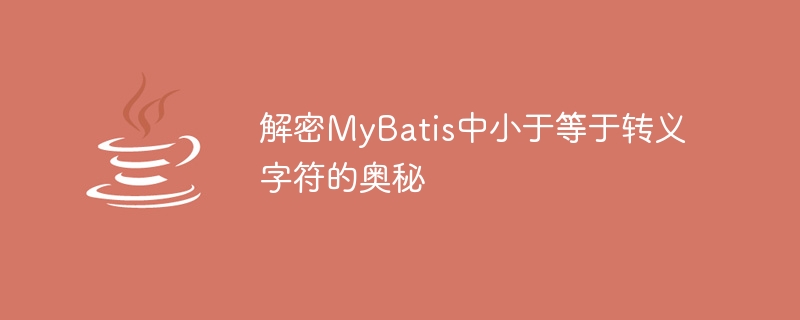Heim >Java >javaLernprogramm >Entschlüsselung des Geheimnisses von kleiner-gleich-Escape-Zeichen in MyBatis
Entschlüsselung des Geheimnisses von kleiner-gleich-Escape-Zeichen in MyBatis
- WBOYWBOYWBOYWBOYWBOYWBOYWBOYWBOYWBOYWBOYWBOYWBOYWBOriginal
- 2024-02-21 22:06:031159Durchsuche

标题:Entschlüsselung des Geheimnisses von kleiner-gleich-Escape-Zeichen in MyBatis
在使用MyBatis进行数据库操作时,经常会遇到需要查询小于等于某个值的情况。在SQL语句中,小于等于的条件通常使用“
在MyBatis中,我们通常使用Mapper接口和Mapper XML文件来进行SQL操作。当我们需要执行小于等于的查询时,我们可以通过在Mapper XML文件中使用小于等于符号“
为了更好地理解和解决这个问题,我们来看一个具体的示例。假设有一张名为“student”的表,表中有字段“score”表示学生成绩。我们想查询小于等于80分的学生记录,我们可以编写如下的Mapper XML文件:
<select id="selectStudentsByScore" parameterType="int" resultType="Student">
SELECT *
FROM student
WHERE score <= #{score}
</select>在上述示例中,我们使用了“
另外,如果我们想通过动态SQL来构造小于等于条件,可以使用MyBatis提供的标签来实现。例如:
<select id="selectStudentsByDynamicScore" parameterType="Map" resultType="Student">
SELECT *
FROM student
WHERE 1=1
<if test="score != null">
AND score <= #{score}
</if>
</select>在这个示例中,我们使用了if标签来判断参数score是否为空,如果不为空则添加小于等于条件。同样需要注意在XML中使用“
除了以上的处理方式,还可以在Mapper接口中直接传入小于等于符号“
public interface StudentMapper {
List<Student> selectStudentsByScore(@Param("score") int score, @Param("symbol") String symbol);
}
在SQL语句中,我们可以这样使用:
<select id="selectStudentsByScoreAndSymbol" parameterType="Map" resultType="Student">
SELECT *
FROM student
WHERE score ${symbol} #{score}
</select>在Java代码中,我们调用Mapper接口的方法时传入小于等于符号“
List<Student> students = studentMapper.selectStudentsByScore(80, "<=");
通过以上的方法,我们可以更灵活地处理小于等于转义字符的情况,确保查询结果符合预期。在实际使用MyBatis时,需要根据具体情况选择合适的处理方式,以确保SQL查询的准确性和效率。希望本文能帮助读者更好地理解和解决MyBatis中小于等于转义字符的奥秘。
Das obige ist der detaillierte Inhalt vonEntschlüsselung des Geheimnisses von kleiner-gleich-Escape-Zeichen in MyBatis. Für weitere Informationen folgen Sie bitte anderen verwandten Artikeln auf der PHP chinesischen Website!

